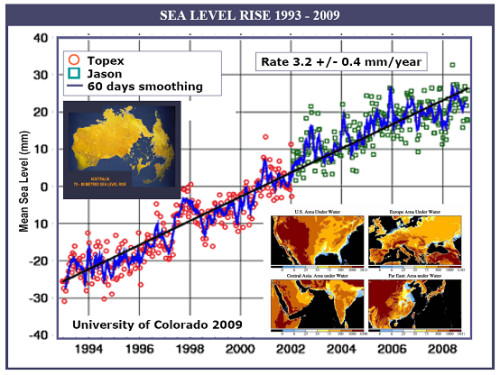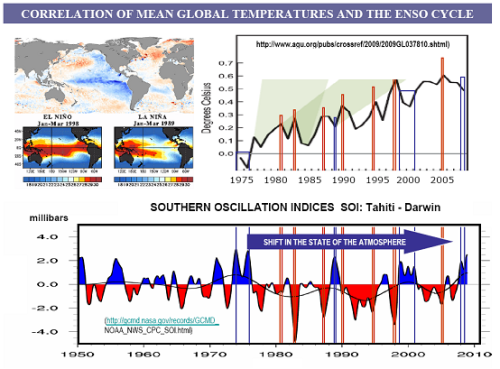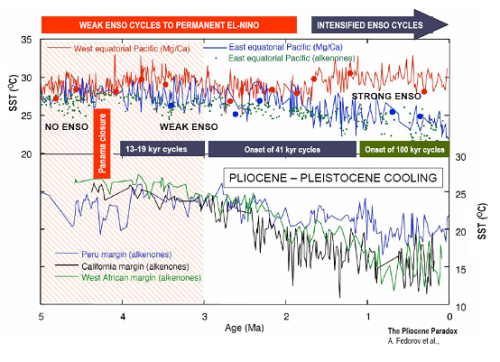“We're simply talking about the very life support system of this planet.” (Joachim Schellnhuber, Director, Potsdam Climate Impacts Institute, advisor to the German government).
The release of more than 320 billion tons of carbon (GtC) from buried early biospheres, adding more than one half of the original carbon inventory of the atmosphere (~590 GtC) to the atmosphere-ocean system, has triggered a fundamental shift in the state of the atmosphere at a rate of 2ppm CO2/year, a pace unprecedented in the geological record with the exception of the effects of CO2 released from craters excavated by large asteroid impacts.
Recent paleoclimate studies, using multiple proxies (soil carbonate δ13C, boron/calcium, stomata leaf pores), indicate that the current CO2 level of 388ppm and CO2-equivalent level of 460ppm (which includes the methane factor), commits warming above pre-industrial levels to 3 to 4 degrees C in the tropics and 10 degrees C in polar regions, leading to an ice-free Earth.
Advertisement
Such conditions existed in the early Pliocene (5.2 Ma) and mid-Pliocene (2.8 Ma) Pliocene, about the time Australopithecine bipeds were emerging from tropical forests. Pliocene climates changed gradually and pre-historic humans responded through migration. There is nowhere the 6.5 billion of contemporary humans can go, not even the barren planets into the study of which space agencies have been pouring more funding than governments allocated for environmental mitigation to date.
It appears difficult to explain to the public and politicians that, at 460ppm CO2-equivalent, the climate is tracking close to the upper stability limit of the Antarctic ice sheet, defined at approximately 500ppm. Once transcended, mitigation measures would hardly be able to re-form the cryosphere, which serves as the Earth’s thermostat, from which cold ocean and wind current emanate - keeping lower latitudes cool. Once the ice melts the atmosphere-ocean system shifts to greenhouse Earth conditions such as existed about 15 million years ago (Ma) (mid-Miocene), before 40 Ma (Eocene), and much of the Cretaceous (141 - 65 Ma), when only small burrowing mammals could live on land.
About 2.8 Ma, the mid-Pliocene, temperatures rose by at least 3 degrees C above pre-industrial and sea levels rose by 25+/-12 meters. About 15 million years ago the rise of CO2 to near~500ppm resulted in global temperatures about 4 degrees C above pre-industrial level and sea level by about 40 metres. Since the early 20th century the rate of sea level rise increased from about 1mm/year to about 3.5 mm/year (1993 - 2009 mean rate 3.2+/-0.4mm/year (Figure 1).

Figure 1. Sea level changes 1993 - 2009 scanned by the Topex and Jason satellites. University of Colorado, 2009.
The world is in a lag period, when the consequences of human greenhouse gas emissions and land clearing are increasingly manifest, including atmospheric energy levels which drive hurricanes and is shifting climate zones towards the poles, with consequent desertification of temperate zones, i.e. southern Europe, southern Australia, southern Africa. The desiccated forests become prey to firestorms, such as in Victoria and California.
Advertisement

Figure 2. Mean global temperature trend 1975 - 2009 [7] and the ENSO cycle, representing the superposition of the el Niño - la Niña cycles on the global warming trend.
Global warming is modulated by the ENSO cycle, including relatively cool la Niña phases (Figure 2). Studiously ignorant climate change deniers, who would like to call themselves “sceptics”, use these cycles to claim “global cooling”. In contravention of basic laws of thermodynamics (Stefan-Boltzmann law, Kirchoff law) which underlie the infrared absorption/emission resonance effect of greenhouse molecules, they invoke the role of short-lived (nine days average atmospheric residence) water vapour but neglect the long-term effects (centuries to millennia) of the well-mixed CO2 and nitric oxides. The increased frequency of the el Niño is tracking towards conditions of permanent el Niño, free from the effects of polar-derived currents (Humboldt Current, California Current). Such conditions existed about 2.8 Ma ago (Figure 3).

Figure 3. Evolution of the ENSO (el Niño Southern Oscillation) cycles from the Pliocene (5.2 - 1.8 million years ago) to the present, showing the divergence of ocean temperatures in the east Pacific Ocean (blue line) from the west Pacific Ocean (red line).
Climate change is appropriately described as a global oxygenation event affecting geological carbon deposits as well as the present biosphere. At 2ppm/year the scale of carbon oxidation exceeds the highest recorded geological rate of 0.4ppm/year, recorded at the Paleocene-Eocene boundary at 55 Ma when about 2000 GtC were burnt, triggering an extinction of species.
Hopes for a meaningful binding agreement in Copenhagen, described as "the most important meeting in the history of the human species" (Joachim Schellnhuber), and for a supposed presidential “Messiah” to wave the magic wand, collapsed in December, 2009, in the sorry mess of vested and tribal interests.
The international system required to protect the lives of the young and future generation is failing. According to the Global Carbon Project “Carbon emissions from the combustion of fossil fuels and land use changes reached almost 10 billion tonnes in 2007”. Those who deny the reality of climate change around the globe seek uncertainties in future climate projections, cf. dates of Himalayan glacier melt or Amazon deforestation. This ignores the evidence for dangerous climate trajectories even where the precise dates of future events can not be determined, namely, Himalayan glaciers melt may precede or postdate 2035. Presumably the claims of “conspiracy” on the part of the scientific world include the pioneers of atmospheric physics (Joseph Fourier, John Tyndall, Svante Arrhenius and Guy Chalendar), as well as those who defined the basic thermodynamic laws of the greenhouse process (Stefan, Bolzmann, Kirschner)?
Most of all those who criticise the IPCC ignore the fact that, to date, the IPCC reports have UNDERESTIMATED ice melt rates, sea level rise, feedback effects and the proximity of tipping points, not least the looming release of hundreds of GtC as methane from permafrost, lake sediments and bogs.
Governments continue to pour the planet’s dwindling resources into wars (US$1.4 trillion in 2008) and bank bailouts (US$0.7 trillion). Entertainment and media are projected to cost US$2 trillion in 2011. Between 1958 and 2009 the US (NASA) spent US$823 billion on space exploration searching for, among other things, water and microbes on other planets. Now they have found water on Mars and the Moon, while the pH of our terrestrial oceans has declined between 1751 and 1994 by 0.075 (8.179 to 8.104), threatening the marine food chain.
Good planets are hard to come by.